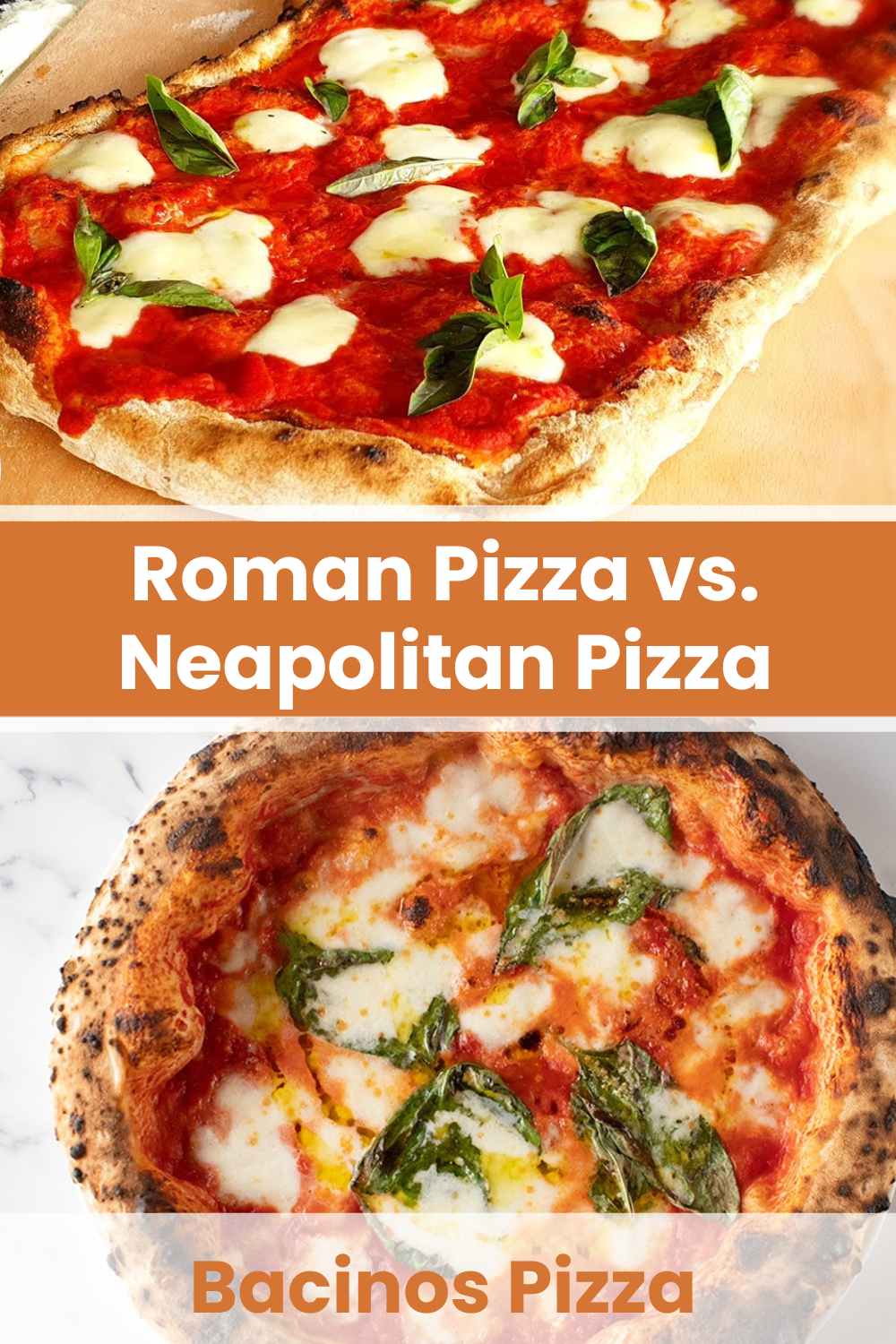
Both Roman-style and Neapolitan pizza originate from Italy, and distinguishing between the two can sometimes be confusing. But don’t worry, as we will guide you through the distinctions and parallels between Roman Pizza and Neapolitan Pizza.
| Feature | Roman Pizza | Neapolitan Pizza |
| City of Origin | Rome | Naples |
| Shape | Rectangular | Circle |
| Crust | Thicker and More Flurry | Thin and Crunchy |
| Baking Oven | Deck Oven (Electric or Gas) Baker’s Hearth | Wood-burned Oven |
| Toppings | San Marzano tomato, Mozzarella, and Basil | Varies |
| Dough | Just flour, water, yeast, and salt | Made with Olive Oil |
| Cooking Time | 3-5 minutes | 8-12 Minutes |
| Serving Method | On the Go | With Knife and Fork |
| Pan | Stainless Steel Pan Carbon Steel pan | No Pan (Directly on Oven Floor) |
What is Roman Style Pizza?

Naples might be hailed as the home of pizza, but Rome can lay claim to its own unique ‘Pizza Romana.’ Marked by a thin crackly crust, it features a unique texture. It’s only achieved through slow fermentation and lower baking heat.
The unique method used to shape it is called “pinsa.” Which requires pressing and extending the pizza dough with olive oil.
It’s evolved from traditional methods for creating pizza and focaccia over many years. The result is a soft, airy pizza with delicious toppings from Italy’s different staples.
Roman pizza showcases three varieties:
- Pizza Al Taglio: The rectangular pizza served in slices with many topping options. This is the most common Roman-style pizza.
- Pizza Tonda Romana: This variety is round and thin with minimal toppings.
- Pizza Bianca: A rarer one with white sauce topped with tomato sauce and cheese.
Unlike the latter pizza, which heavily relies on tradition, Roman-style pizza merges modernity and the old times. This style of pizza is never meant for fine dining. It’s an on-the-go variety that shows the creativity of Italians in the face of ever-growing modern times.
What is Neapolitan Pizza?

Neapolitan pizza is one of the most popular dishes in the renowned city of Naples. It’s known for its distinct cooking method.
Instead of slow baking, this pizza variety cooks fast in very high heat. It’s due to its paper-thin crust of around 1-2cm thick. The result is a pizza with raised edges, also known as cornice.
Along with its unique crust, Neapolitan boasts an almost dish-like center. There sit its toppings of San Marzano tomatoes, basil, and mozzarella di bufala. Except for basil, the sauce and cheese also need to be DOP certified to be used.
The result is a genuine look into the taste of Italy. So, it’s no wonder that this pizza is a staple in many Italian restos and pizzeria.
It claims a TSG classification, Traditional Specialty Guaranteed, thus distinguishing itself from Roman-style pizzas. With strict adherence to AVPN certification principles, it must also be produced according to specific parameters to pass as Traditional Neapolitan Pizza.
What makes Neapolitan Pizza Special?
If you check the prices for this pizza, you might be shocked that it’s sold at a higher price. Well, it’s for a good reason.
As stated, Neapolitan pizza is more than just food. It’s a protected cultural heritage from the city of Naples. Thus, it’s a specialty that many pizzerias can’t just serve.
That’s why making it to the criteria is more complex and pricier. Not just with the specific ingredients but with the effort pizzerias must make to get the credentials to prove their pizza is authentic.
A Brief History of Roman vs. Neapolitan Pizza

Neapolitan pizza has a centuries-old history, originating in Naples, Italy, in the 18th century. Deemed by many to be founders of modern pizza, Neapolitan-style pizzas are distinguished by their light-colored thin crust, which gives it a soft yet chewy texture and a puffy outer rim.
Most notably, it inspires the Margherita pizza, created to pay homage to Queen Margherita of Savoy. The flavors represent The Colors of Italy: Red tomatoes, white mozzarella, and green basil.
On the other hand, Roman-style pizza can be traced back to the mid-20th century. Pizza al Taglio is a style of pizza rooted in Rome’s vibrant and bustling streets. It’s said to be used to combat hunger while providing cheap and convenient snacks for the working class.
This notable type of pizza usually has a large and raised crust cut in rectangles. Its distinct trait is its practical shape which makes it more convenient. It’s a sign that Rome is becoming more and more industrial.
Roman-style Pizza vs. Neapolitan Pizza: The Similarities
Both of these iconic pizzas have their own unique flair. However, they also have many similar elements, such as:
- Basic Ingredients: Much like with many dishes in the same cuisine, these two pizza shares many of the same elements. For example, they use flour, yeast, and salt for their dough. Along with that is the use of tomato sauce and cheese, although they vary in type.
- Cultural Significance: Both Roman and Neapolitan pizza are very important to Italian cuisine.
Roman-style Pizza vs. Neapolitan Pizza: The Differences

Pizza Napoletana and Pizza Romana might have the same roots in Italian cuisine but have unique features worth highlighting. Here are some elements that you can tell one from the other!
City of Origin
To begin, the first one is a staple from Naples. Meanwhile, as evident by its name, the latter came from Rome and Central Italy.
Ingredients and Appearance
Another striking one is their shape and toppings. Neapolitan has a thin circle-shaped crust with classic toppings like mozzarella and basil. Meanwhile, the Roman pizza has a thicker, rectangular shape served with more variety in toppings such as sausage or potato.
The Neapolitan dough is crafted with only four primary ingredients: flour, water, yeast, and salt. The Roman version adds olive oil to achieve a heartier and crispier taste.
Roman style may be the way to go for those who are into a wider variety of toppings. You’ll have the freedom to top your pizza with whatever you want. It can range from vegetables, cured meats, seafood, and even a variety of cheeses!
On the other hand, Neapolitan pizza is all about tradition! Typically, it will feature high-quality ingredients like fresh mozzarella, San Marzano tomatoes, basil, and olive oil. The focus is more on the quality of key components than the sheer number of toppings.
Serving Method
In Naples, pizza is usually for eating whole (not slice by slice) and served with a knife and fork. Meanwhile, it is cut into pieces in Rome before serving as it’s the go dish. You will notice Roman pizza being sold in the streets or stalls rather than in pizzerias.

Cooking Method and Texture
Both recipes require particular oven time to bring out their unique textures. Neapolitan only takes from 60 to 90 as it has a thinner crust, but Roman-style cooks in the 25-minute mark.
The thin and crunchy crust typical of Roman pizza is perfect for anyone looking for a satisfying crunch with each bite. Alternatively, the crunchy and chewy Neapolitan pizza is cooked at a higher temperature for a shorter time. This cooking method gives this pizza its puffy edge (or ‘cornicione’) and slightly charred bottom.
Cultural and Regional Distinctions: Neapolitan vs. Roman Pizza
These pizzas are not just food. They are a sign of the ever-growing Italian cuisine. So here is how these pizzas left a cultural mark in the world!
Neapolitan Pizza

In 2017, Naples received excellent news. The Neapolitan pizza now belongs to the UNESCO Intangible Cultural Heritage recognition. It’s no surprise that this way of making pizza is now recognized for its cultural impact.
This art form is passed down to trained “pizzaiuoli.” Thus, it makes for a linked tradition. Today, Naples boasts around 3000 trained pizzaiouli that continue to serve authentic Neapolitan pizza.
Established in 1988, the Association of Neapolitan Pizzaiuoli has made its mark in history. Not only have they sponsored testimonies to UNESCO, but they also opened their “bottega” more recently. They offer admission for 120 apprentices every year!
To top it off, in 2013, the Association set up a first-of-its-kind international pizzaiuoli museum dedicated to preserving history.
Roman Pizza

While it may not have the UNESCO recognition, Roman pizza is still a proud representative of Italian culture. This type of on-the-go food reflects the bustling, modern energy of the city. It’s a sign that the working class is growing with their need for quick and easy meals.
It shows the ingenuity of Rome. With their ever-evolving topping options, it’s also an indicator of the market.
Roman-style Pizza vs. Neapolitan Pizza: Which one is for you?
Choosing between the two is a decision purely based on your taste and budget. If you’re planning to taste a simple yet high-quality intro to Italian cuisine, then try out the Neapolitan. Especially in Naples, it’s an opportunity you should not pass!
Meanwhile, if you want a more convenient snack that is open worldwide, you can try out the Roman style. It’s more giving when it comes to the toppings. So, you’ll find one that will suit your taste.
Conclusion
In summary, there is no better pizza between these two iconic giants. Both boast a unique flair to the cuisine. So between Roman vs. Neapolitan Pizza, the choice lies with you!

Barbara is an enthusiastic food-exploring person that goes through different culinary experiences. She got inspired by creating a pizza blog post after she tasted one of the best-selling pizzas in Toledo.